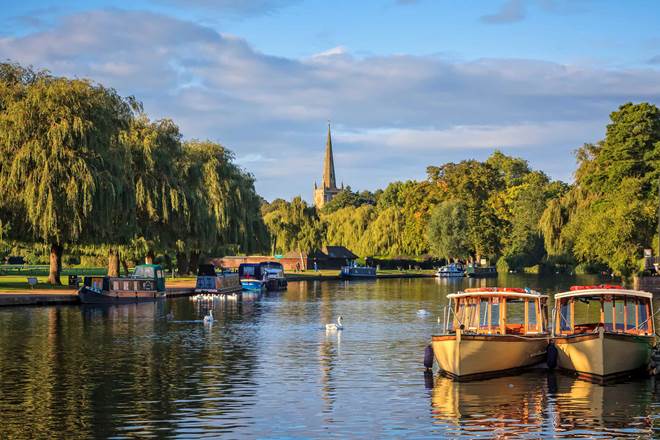Would you like to jump on a train that takes you back in time to cobblestone streets, timbered houses, and elevated style?
Bringing all of these to life is easy in Stratford-upon-Avon, an English town that breathes the legacy of William Shakespeare.
Image Credit: Getty Images, Travelpix Ltd. Image Location: Stratford-upon-Avon, England
Stratford-upon-Avon: the 16th century and today
Where is Stratford-upon-Avon?
Stratford-upon-Avon is located in Warwickshire, England, UK. Shakespeare’s hometown is easily accessible by train, and this is quite a scenic journey.
What was important about Stratford-upon-Avon in the 16th century?
In the 16th century, Stratford-upon-Avon was already a bustling market town. Its claim to fame, however, skyrocketed after the birth of William Shakespeare in 1564. The town’s architecture and ambience still reflect this era’s charm.
Image Credit: Getty Images, Jorisvo. Image Location: Stratford-upon-Avon, England
How to get to Stratford-upon-Avon by train
To get to Stratford-upon-Avon by train, follow these steps:
- Start from London. If you’re in London, your journey begins from one of the major train stations like London Paddington (2 changes), London Euston (2 changes), or London Marylebone (1 change).
- Pick the train route. Find a train service that connects London to Stratford-upon-Avon. Chiltern Railways, CrossCountry, and West Midlands Railway are common train operators for this route.
- Purchase tickets. Buy your digital train tickets in advance with the Trainline app. You can also do this through the official websites of train operators or at the train station.
- Depart from London. Head to the designated platform at the train station from which your train to Stratford-upon-Avon departs. You can always double-check the platform in our app.
- Board the train. When the train arrives, board it and find your reserved seat or a suitable place to sit if your ticket doesn’t have a seat reservation.
- Enjoy the journey. Relax and enjoy the scenic journey as the train takes you from London to Stratford-upon-Avon. You’ll pass through the beautiful English countryside.
- Arrive at Stratford-upon-Avon. The train will stop at Stratford-upon-Avon train station. You’ve reached your destination!
From the train station, you can easily explore the town on foot or by buses or taxis.
The Royal Shakespeare Company: a beacon of the Bard’s brilliance
Image Credit: Getty Images, stevegeer. Image Location: Stratford-upon-Avon, England
What is the Royal Shakespeare Company?
The Royal Shakespeare Company (RSC) is a major British theater company. They started in 1961, and their main job is to make Shakespeare’s works and some contemporary plays come alive on stage. The RSC performs regularly in London, Stratford-upon-Avon, and on tour across the UK and internationally.
Where is the Royal Shakespeare Company based?
The RSC is based in Stratford-upon-Avon and shares the same address as the Royal Shakespeare Theater located in the middle of the city (postcode CV37 6BB).
Where to see Royal Shakespeare Company’s Hamlet and Othello?
You can see the Royal Shakespeare Company’s productions of Hamlet and Othello at the Royal Shakespeare Theater in Stratford-upon-Avon. The RSC sometimes tours their productions, including Hamlet and Othello, to various locations both within the United Kingdom and internationally. These locations vary each season. For the most current information on where the RSC is performing, check their official website or contact their box office.
Image Credit: Getty Images, RichardHayman13. Image Location: Stratford-upon-Avon, England
10 fun facts about Stratford-upon-Avon and the Royal Shakespeare Company
- Stratford’s ancient market. Stratford-upon-Avon has hosted a market since 1196, making it one of the oldest in the UK.
- The RSC’s Swan Theater. Originally built in 1879, the Swan Theater was restored by the RSC in the 1980s and is known for its intimate atmosphere, resembling an Elizabethan playhouse.
- Shakespeare’s schooling. Shakespeare likely attended the King Edward VI School in Stratford-upon-Avon, a still-functioning school where visitors can explore the very classroom Shakespeare might have studied in.
- RSC’s unique archive. The RSC maintains a vast archive of its productions, including rare photographs, costumes, and props, some of which can be viewed by appointment or during special exhibitions.
- Garrick’s Jubilee. Actor David Garrick, who significantly boosted Shakespeare’s popularity in the 18th century, organized a major jubilee in Stratford-upon-Avon in 1769, which helped solidify the town’s association with Shakespeare.
- The Dirty Duck. A popular pub near the RSC theaters, The Dirty Duck (also known as The Black Swan), is frequented by actors and theater-goers alike, and its walls are adorned with pictures of famous actors who have performed with the RSC.
- Stratford’s canal locks. The town is at the head of the Stratford-upon-Avon Canal, which features a unique series of canal locks, drawing visitors for both their historical and engineering interest.
- Shakespeare’s New Place. The site of Shakespeare’s final home, New Place, where he died in 1616, is now a garden and exhibition space, as the original house was demolished in the 18th century.
- RSC’s eco-friendly lighting. The Royal Shakespeare Theater was one of the first in the world to adopt a revolutionary low energy lighting system, reflecting the company’s commitment to sustainability.
- The Gower Memorial. Located in Bancroft Gardens, this memorial features statues of Shakespeare and four characters from his plays representing philosophy, tragedy, comedy, and history, and is a popular spot for photographs.
In Stratford-upon-Avon, every cobblestone, every tavern, and every whisper of the Avon River seems to echo with lines from Shakespeare. So, grab your e-ticket, hop on that train, and get ready to mix a bit of ye olde with a dash of the new. Curtain up!
Header Image Credit: Getty Images, Tu xa Ha Noi. Image Location: Stratford-upon-Avon, England

